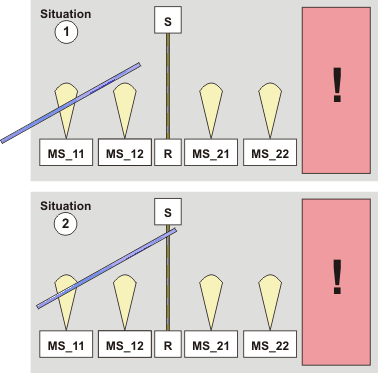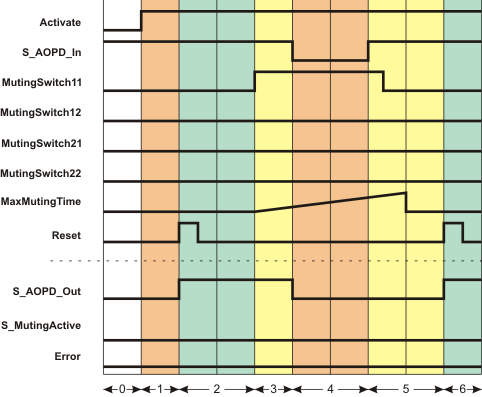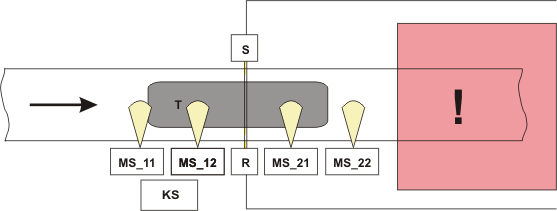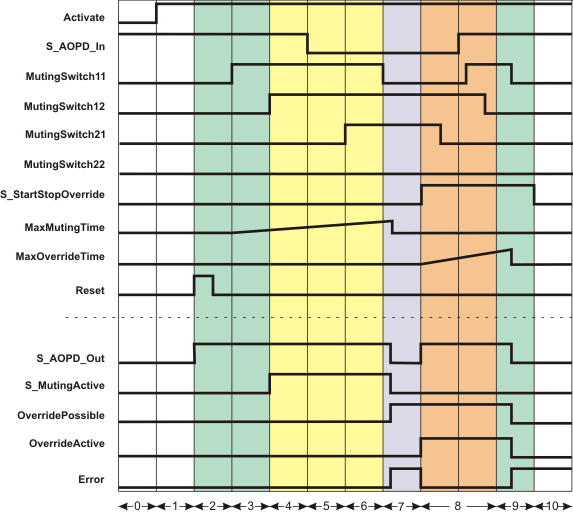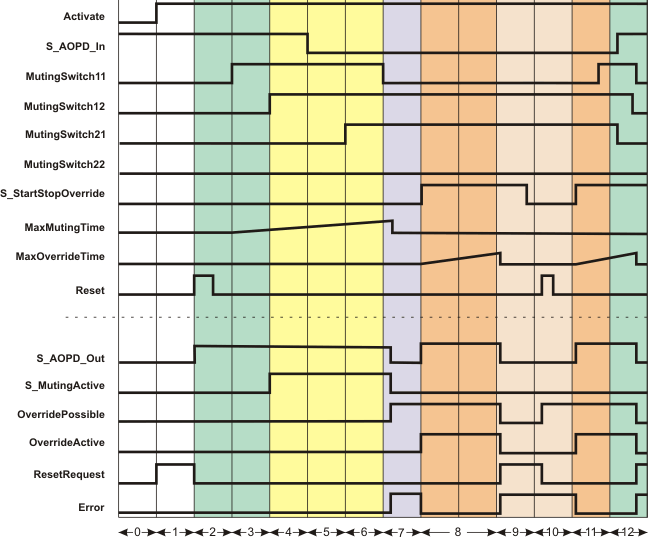Additional signal sequence diagrams
Temporary intermediate states are not illustrated in the signal sequence diagram. Only typical input signal combinations are illustrated in this diagram. Other signal combinations are possible.
The most significant areas within the signal sequence diagram are highlighted in color.
| Further Info
The diagram in the overview for this function block must also be taken into account. |
| Note
Only the material flow direction from muting sensors MutingSwitch11  MutingSwitch12 to muting sensors MutingSwitch21 MutingSwitch12 to muting sensors MutingSwitch21 MutingSwitch22 is described in the following. This means the sequential muting sensor pair MutingSwitch11/MutingSwitch12 is positioned before the safety-related equipment and MutingSwitch21/MutingSwitch22 is behind the safety-related equipment. This is illustrated in the graphic in the function block overview. MutingSwitch22 is described in the following. This means the sequential muting sensor pair MutingSwitch11/MutingSwitch12 is positioned before the safety-related equipment and MutingSwitch21/MutingSwitch22 is behind the safety-related equipment. This is illustrated in the graphic in the function block overview.The function block also supports the opposite material flow direction from muting sensors MutingSwitch22  MutingSwitch21 to muting sensors MutingSwitch12 MutingSwitch21 to muting sensors MutingSwitch12 MutingSwitch11. The functional sequence remains identical. MutingSwitch11. The functional sequence remains identical. |
Object in zone of operation, muting inactive, stop request via safety-related equipment, start-up inhibit active
The signal sequence diagram shown below indicates what happens if an object (e.g., a rod) interrupts the light beam of the first muting sensor located before the safety-related equipment (see situation (1)) and then moves forward to enter the zone of operation of the protected machine, i.e., also interrupts the light beam of the safety-related equipment (see situation (2)). This triggers a stop request because muting is not active. To activate muting for the material flow direction mentioned, the muting sensors at the inputs MutingSwitch11 and MutingSwitch12 must switch to TRUE in the correct sequence, i.e., MutingSwitch11 must first detect the object and then MutingSwitch12, i.e., switch to TRUE.
MS_11, MS_12: First sequential muting sensor pair, connected to function block inputs MutingSwitch11 and MutingSwitch12 (the "yellow light beams" symbolize the detection area)
MS_21, MS_22: Second sequential muting sensor pair, connected to function block inputs MutingSwitch21 and MutingSwitch22
Additional assumptions:
- S_StartReset = SAFEFALSE: Start-up inhibit after the function block has been activated and after the Safety PLC has started up.
- MutingEnable = TRUE (constant): No separate enable signal required for the muting operation.
| 0 | The function block is not yet activated (Activate = FALSE). As a result, all outputs are FALSE or SAFEFALSE. |
| 1 | After the function block has been activated by Activate = TRUE, the start-up inhibit is active at first. Therefore, the S_AOPD_Out enable output remains SAFEFALSE. |
| 2 | A positive signal edge at the Reset input resets the start-up inhibit.The S_AOPD_Out output becomes SAFETRUE immediately because
|
| 3 | The object in our example interrupts the light beam of the muting sensor at the MutingSwitch11 input, thus switching the signal to TRUE (situation (1) in the graphic above).The time measurement for the overall muting duration set at MaxMutingTime starts after this state change at MutingSwitch11. |
| 4 | Before muting can be activated (for which the signal at the MutingSwitch12 input must also switch to TRUE), the rod also interrupts the light grid of the safety-related equipment (situation (2) in the graphic above), i.e., S_AOPD_In switches to SAFEFALSE.When S_AOPD_In switches to SAFEFALSE, the muting operation is canceled. As a result, the enable output S_AOPD_Out is switched to SAFEFALSE. |
| 5 | The rod has been removed from the detection area of the safety-related equipment and the muting sensor. This switches S_AOPD_In to SAFETRUE and MutingSwitch11 to FALSE again.Although the light beams of all sensors are no longer interrupted, the S_AOPD_Out enable output remains SAFEFALSE, as a positive edge is first expected at the Reset input. |
| 6 | A positive signal edge at the Reset input resets the start-up inhibit. As S_AOPD_In = SAFETRUE (light beam of the safety-related equipment is not interrupted), the S_AOPD_Out output switches to SAFETRUE. |
Error-free use of the override function
The signal sequence diagram shown below illustrates a muting operation with override function, using the example of an impermissible object on an assembly conveyor that ends at a zone of operation with a running machine. This is illustrated in the graphic below:
The signal sequence diagram demonstrates an error-free override operation that ends automatically after the object has been removed from the zone of operation.
Additional assumptions:
- S_StartReset = SAFEFALSE: Startup inhibit after the function block has been activated and after the Safety PLC has started up.
- MutingEnable = TRUE (constant): No separate enable signal required for the muting operation.
Steps 0 to 6 correspond to the signal sequence diagram for error-free muting in the function block overview.
| 0 | The function block is not yet activated (Activate = FALSE). As a result, all outputs are FALSE. |
| 1 | After the function block has been activated by Activate = TRUE, the startup inhibit is active at first. The S_AOPD_Out output therefore first remains SAFEFALSE. |
| 2 | A positive signal edge at the Reset input resets the startup inhibit.The S_AOPD_Out output switches immediately to SAFETRUE (normal operation) because
|
| 3 | The first muting sensor of the first sequential sensor pair (before the safety-related equipment) at the MutingSwitch11 input detects an object and switches to TRUE. The time measurement for the overall muting duration starts after this state change at MutingSwitch11. The maximum permissible duration is specified at the MaxMutingTime input. |
| 4 | The second muting sensor of the first sequential sensor pair also detects the object (the MutingSwitch12 input switches to TRUE).This meets the requirements for a valid muting sequence, i.e, that the object is identified as permissible and the S_MutingActive output switches to SAFETRUE as a result: Muting is active. |
| 5 | The object reaches the light grid: the S_AOPD_In input switches to SAFEFALSE ("light grid interrupted"). As muting is active (MutingSwitch11 and MutingSwitch12 are still TRUE), the machine may continue to run in the zone of operation: the S_AOPD_Out output remains SAFETRUE. |
| 6 | The object reaches the first muting sensor of the second sequential sensor pair (behind the safety-related equipment): the MutingSwitch21 input switches to TRUE. The muting sequence is valid because both muting sensors of the first sensor pair are still TRUE. As a result, outputs S_AOPD_Out and S_MutingActive both remain SAFETRUE. The time measurement for the overall muting duration (MaxMutingTime timer) continues to run. |
| 7 | The MutingSwitch11 muting sensor detects no object anymore and switches to FALSE before the MutingSwitch22 muting sensor switches to TRUE (the light grid is still interrupted, i.e., S_AOPD_In = SAFEFALSE).This means a muting error occurs and the Error output switches to TRUE.Muting is immediately deactivated (the S_MutingActive output switches to SAFEFALSE and the MaxMutingTime timer is stopped) and the machine must not continue to run in the zone of operation. The S_AOPD_Out output switches to SAFEFALSE.The requirements for an override operation are given. The OverridePossible output switches to TRUE. |
| 8 | The operating personnel requests the override operation via a control device (S_StartStopOverride input switches to SAFETRUE). The OverrideActive output switches to TRUE.The override time measuring starts. The maximum permissible duration is specified at the MaxOverrideTime input. As a result of the active override operation, the Error output switches to FALSE.The S_AOPD_Out output switches to SAFETRUE, as the override operation is active.Now, the object can be removed from the zone of operation. |
| 9 | The override operation is exited automatically, as the object has been removed (all muting sensors are FALSE) and the light grid detects no object anymore (input S_AOPD_In = SAFETRUE).After the successful override operation the Error output switches to TRUE again because the previous muting error must first be confirmed by a reset request. The S_AOPD_Out output thus switches to SAFEFALSE. |
| 10 | The operator releases the control device for the override function. However, this has no more effect, as the override operation has already been completed automatically. As long as there is no reset request by the operator, the Error output remains TRUE and the S_AOPD_Out output SAFEFALSE. A positive signal edge at the Reset input initiates the reset. |
Errors during the override operation, e.g., override timer has elapsed
The signal sequence diagram shown below illustrates a muting operation with override function, using the example of an object on an assembly conveyor that ends at a zone of operation with a running machine. It demonstrates the behavior when the override timer (MaxOverrideTime input) elapses during the override operation. This is illustrated in the graphic below.
Additional assumptions:
- S_StartReset = SAFEFALSE: Startup inhibit after the function block has been activated and after the Safety PLC has started up.
- MutingEnable = TRUE (constant): No separate enable signal required for the muting operation.
| 0 | The function block is not yet activated (Activate = FALSE). As a result, all outputs are FALSE. |
| 1 | After the function block has been activated by Activate = TRUE, the startup inhibit is active at first. ResetRequest = TRUE indicates that you need a Reset to reset the startup inhibit. |
| 2 | A positive signal edge at the Reset input resets the startup inhibit.The S_AOPD_Out output switches immediately to SAFETRUE (normal operation) because
|
| 3 | The first muting sensor of the first sequential sensor pair (before the safety-related equipment) at the MutingSwitch11 input detects an object and switches to TRUE. The time measurement for the overall muting duration starts after this state change at MutingSwitch11. The maximum permissible duration is specified at the MaxMutingTime input. |
| 4 | The second muting sensor of the first sequential sensor pair also detects the object (the MutingSwitch12 input switches to TRUE).This meets the requirements for a valid muting sequence, i.e, that the object is identified as permissible and the S_MutingActive output switches to SAFETRUE as a result: Muting is active. |
| 5 | The object reaches the light grid: the S_AOPD_In input switches to SAFEFALSE ("light grid interrupted"). As muting is active (MutingSwitch11 and MutingSwitch12 are still TRUE), the machine may continue to run in the zone of operation: the S_AOPD_Out output remains SAFETRUE. |
| 6 | The object reaches the first muting sensor of the second sequential sensor pair (behind the safety-related equipment): the MutingSwitch21 input switches to TRUE. The muting sequence is valid because both muting sensors of the first sensor pair are still TRUE. As a result, outputs S_AOPD_Out and S_MutingActive both remain SAFETRUE. The time measurement for the overall muting duration (MaxMutingTime timer) continues to run. |
| 7 | The MutingSwitch11 muting sensor detects no object anymore and switches to FALSE before the MutingSwitch22 muting sensor switches to TRUE (the light grid is still interrupted, i.e., S_AOPD_In = SAFEFALSE).This means a muting error occurs and the Error output switches to TRUE.Muting is immediately deactivated (the S_MutingActive output switches to SAFEFALSE and the MaxMutingTime timer is stopped) and the machine must not continue to run in the zone of operation. The S_AOPD_Out output switches to SAFEFALSE.The requirements for an override operation are given. The OverridePossible output switches to TRUE. |
| 8 | The operating personnel requests the override operation via a control device (S_StartStopOverride input switches to SAFETRUE). The OverrideActive output switches to TRUE.The override time measuring starts. The maximum permissible duration is specified using the MaxOverrideTime input. As a result of the active override operation, the Error output switches to FALSE.The S_AOPD_Out output switches to SAFETRUE, as the override operation is active.Now, the object can be removed from the zone of operation. |
| 9 | An override error has occured because the override timer (MaxOverrideTime input) has elapsed before the object could be removed completely from the zone of operation.As a result, the Error output becomes TRUE, and the output S_AOPD_Out switches to SAFETRUE. The outputs OverridePossible and OverrideActive switch to FALSE. A reset is required because of the override error and this is signaled at the ResetRequest output (ResetRequest = TRUE). The operator releases the key switch (input S_StartStopOverride = SAFEFALSE), but there is no further effect. |
| 10 | A positive signal edge at the Reset input initiates the reset.With the reset the requirements for the override function are given again because at least one of the muting sensors still detects an object (MutingSwitch12 = TRUE and MutingSwitch21 = TRUE) and the error state still remains (Error = TRUE). The OverridePossible output thus switches to TRUE. |
| 11 | Now, the operator can start an override operation again (input S_StartStopOverride = SAFETRUE). The override timer (MaxOverrideTime input) starts again.The output OverrideActive becomes TRUE and S_AOPD_Out switches to SAFETRUE, the Error output switches to FALSE again. The removal of the object from the zone of operation can be continued. |
| 12 | With the switch of MutingSwitch11 to FALSE (all the other sensors are already FALSE) the requirements for the automatic exit of the override operation are met:
|
